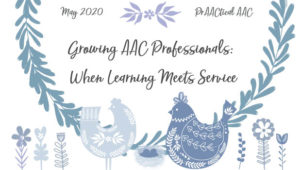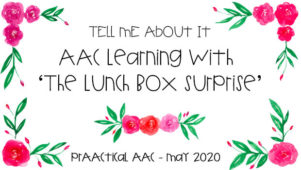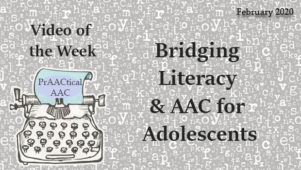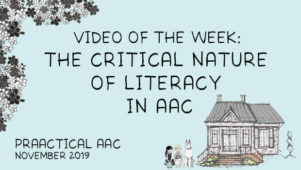Letters from Camp, Part 2 (Working with Words)
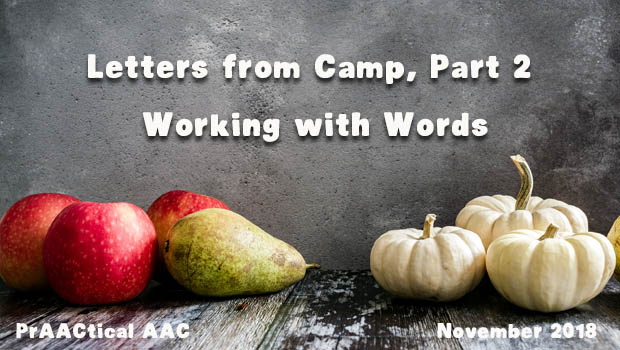
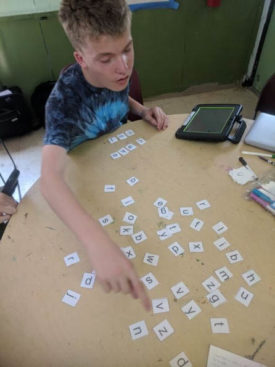 The weather is nippy here in Boston where 12,000+ professionals are gathered for the annual ASHA Convention, and the blustery wind makes us think back longingly to the warmer days of summer. Today. Ohio-based SLP Tina Moreno helps us do just that as she returns to share more information on the reading and writing activities that AAC learners in Camp ALEC experienced. In today’s post, she shares some of the details about Working with Words.
The weather is nippy here in Boston where 12,000+ professionals are gathered for the annual ASHA Convention, and the blustery wind makes us think back longingly to the warmer days of summer. Today. Ohio-based SLP Tina Moreno helps us do just that as she returns to share more information on the reading and writing activities that AAC learners in Camp ALEC experienced. In today’s post, she shares some of the details about Working with Words.
If you missed it the first time, you can visit Tina’s earlier post here. Many thank to AAC mom and SLP Tina Moreno for giving us a peek into the wonderful instruction provided to these AAC learners!
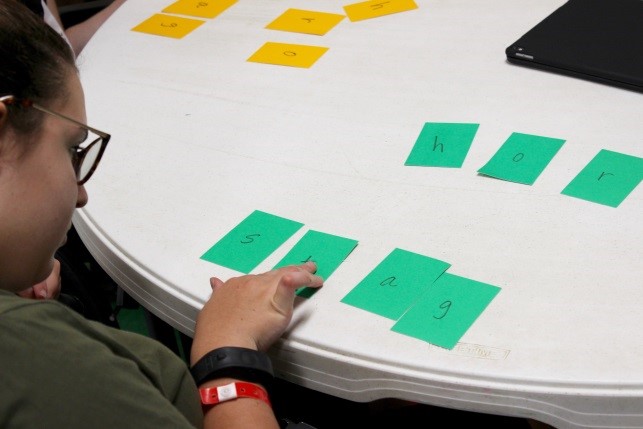 :::::::::::::::::::::::::::::::::::::::::::::::::::::::::::::::::::::::::::::::::::::::::::::::::::::::::::
:::::::::::::::::::::::::::::::::::::::::::::::::::::::::::::::::::::::::::::::::::::::::::::::::::::::::::
Working with Words at Camp ALEC
At Camp ALEC in August, our literacy counselors planned fun, motivating activities that helped our campers learn to read and write new words. In another setting, we might refer to these literacy counselors as teachers or speech-language pathologists, but not at Camp ALEC, where we throw out the fancy educational titles and use first names only. Back at home, we’d probably refer to these activities as lessons, but not at Camp ALEC, where we do NOT refer to literacy as work. Instead, manipulating letters to make new words – and attributing meaning to those words — is enjoyable and engaging. Campers work hard (and don’t realize they’re doing it) because they’re having fun and learning to connect text to communicating. The setting is relaxed, but expectations are very high. We believe in our campers and they learn to believe in themselves as well.
Most Working with Word activities help learners to utilize key words – or anchor words – they already know. In the case of AAC users, these anchor words are likely core words on their robust AAC systems. These anchor words are words they can already spell, read and use in their day-to-day communication across multiple settings. Learners are guided through the process of comparing and contrasting new, unfamiliar words to those words that are already in their own personal lexicon. A few examples of such activities include a Word Wall, Word Sorts, Comparing/Contrasting and Making Words.
Word Wall
When creating a Word Wall, it’s a good idea to organize those words around core vocabulary words that AAC communicators use every day to communicate in a variety of contexts. The Word Wall can then be used as a tool for children to refer to when they are learning to read and write new words. In order for children to learn how to use their Word Wall as a tool, adults plan daily activities that incorporate use of the Word Wall. At camp, our literacy counselors constructed Word Walls throughout the week, adding words to the wall as they became more and more familiar with their campers. The Word Wall became a resource for campers, which they began to reference often. Below are some examples of Word Wall activities:
- Dictate sentences using only Word Wall words.
- Spell Word Wall words that share a spelling pattern with rhyming words.
- Practice adding endings to words to talk about every day happenings (example: add “s” to make waits, then “ed” to make “waited”, then “ing” to make “waiting”
- Play I Spy (example: “I’m thinking of a word on the wall. It has 4 letters. It is on a blue card. It rhymes with the word like. It starts with the sound /b/. The word is…”
Word Sorts
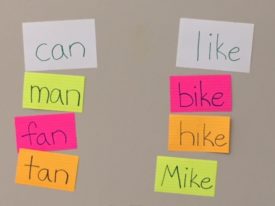 We saw many examples of Word Sorts at camp this summer. Guiding children through the process of sorting words helps them learn to actively compare and contrast words while utilizing their own personal lexicon as a tool. We began Word Sorts by selecting two key words that the campers already know how to read, write and communicate. Many of our campers participated in these activities using partner assisted scanning to direct their literacy counselors on how they’d like the words to be sorted or spelled. Here are three examples of Word Sorts we practiced at camp:
We saw many examples of Word Sorts at camp this summer. Guiding children through the process of sorting words helps them learn to actively compare and contrast words while utilizing their own personal lexicon as a tool. We began Word Sorts by selecting two key words that the campers already know how to read, write and communicate. Many of our campers participated in these activities using partner assisted scanning to direct their literacy counselors on how they’d like the words to be sorted or spelled. Here are three examples of Word Sorts we practiced at camp:
- Visual Sorts – Campers were given printed words, one at a time, and asked to sort them by spelling pattern with corresponding key words at the top. Together, campers compared and contrasted each new word with its matching key word.
- Auditory Sorts – Campers listened to words and were asked to indicate which key word shared the same spelling pattern. They were then given the opportunity to see each word to visually confirm whether they were correct. Together, you can then compare and contrast each new word with its matching key word.
- Spelling Sorts – Campers listened to a word sharing the same spelling pattern as one of their two key words. They were asked to indicate which key word shared the same spelling pattern. They were directed to attempt to spell each word using the key word to help them spell the new word. Then campers were shown the new word and asked to compare/contrast their attempts to spell the word with the target, working together to make corrections as necessary.
Making Words
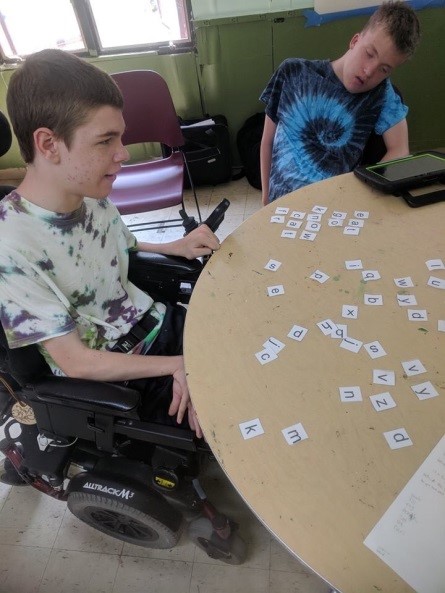
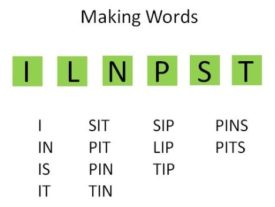 The Making Words instructional activity allows learners to practice constructing new words from existing words using a systematic approach. Depending on the group, the instructor selects 5-6 letter words (starting with only on vowel), then guides learners in making 1-, 2-, 3- and 4-letter words. It’s recommended that a systematic approach is taken, changing only one letter at a time. Learners can then practice sorting their new words by: beginning sound; number of letters; and word endings. At camp, however, our Making Words activities were often less formal with campers selecting letters from a larger pool to make words fast and furiously in an effort to score more points than an opponent.
The Making Words instructional activity allows learners to practice constructing new words from existing words using a systematic approach. Depending on the group, the instructor selects 5-6 letter words (starting with only on vowel), then guides learners in making 1-, 2-, 3- and 4-letter words. It’s recommended that a systematic approach is taken, changing only one letter at a time. Learners can then practice sorting their new words by: beginning sound; number of letters; and word endings. At camp, however, our Making Words activities were often less formal with campers selecting letters from a larger pool to make words fast and furiously in an effort to score more points than an opponent.
Compare/Contrast
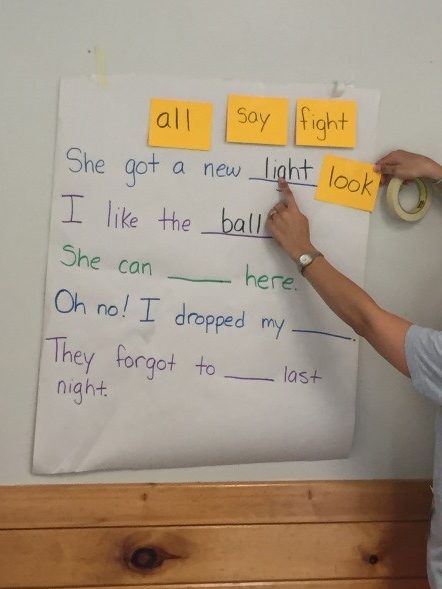 This is another favorite camp activity that encouraged campers to practice reading new words while utilizing key words they can already read, write and communicate. Literacy counselors provided 3-4 key words the campers already knew and then wrote a sentence on the board using a new word that contained the same spelling pattern as one of their key words. The campers were asked to identify which key word they could use to help them read the new underlined word.
This is another favorite camp activity that encouraged campers to practice reading new words while utilizing key words they can already read, write and communicate. Literacy counselors provided 3-4 key words the campers already knew and then wrote a sentence on the board using a new word that contained the same spelling pattern as one of their key words. The campers were asked to identify which key word they could use to help them read the new underlined word.
:::::::::::::::::::::::::::::::::::::::::::::::::::::::::::::::::::::::::::::::::::::::::::::::::::::::::::::::::::::::::::::::::::::::::::::::::::::
More About Camp ALEC
Camp ALEC is a literacy camp for children who use AAC devices and who have physical disabilities. It’s an overnight camp that promotes communication all week long during daily literacy sessions and recreational activities including adapted rockwall climbing, zip lining, swimming, boating, talent shows, silly pranks and other shenanigans. Last summer, 21 campers spent the week learning [and laughing] with educators from across the U.S. and Canada who attended camp to receive hands-on, intensive training in literacy assessment and instruction under the direction of Drs. Karen Erickson and David Koppenhaver. Throughout the week, campers worked 1:1 and in small groups on reading and writing in activities that are so fun that campers could hardly differentiate their literacy counselors from the camp counselors who provided their care and orchestrated a beautiful typical summer camp experience.
Want to learn more about instructional strategies for conventional literacy learners?
Join us for an intensive three-day workshop in Cleveland offered March 11-13 that will focus on conventional literacy instruction for students with moderate to significant disabilities. This event is called Conventional Literacy Instruction for Students with Significant Disabilities and Complex Communication Needs (click here for more information). The presenters are internationally recognized experts in the field of literacy, communication and disabilities. Drs. Karen Erickson and David Koppenhaver will guide participants in learning how to provide daily comprehensive literacy instruction that includes word study, self-directed reading, reading comprehension, and writing. Course participants will examine student work samples, videos of classroom instruction, methods of instruction, and theoretical frameworks supporting universal literacy. The course is open to parents, administrators, educators and related services personnel concerned with supporting communication and literacy in these students.
Filed under: Featured Posts, PrAACtical Thinking
Tagged With: Camp ALEC, literacy, phonic, Tina Moreno, working with words
This post was written by Carole Zangari

